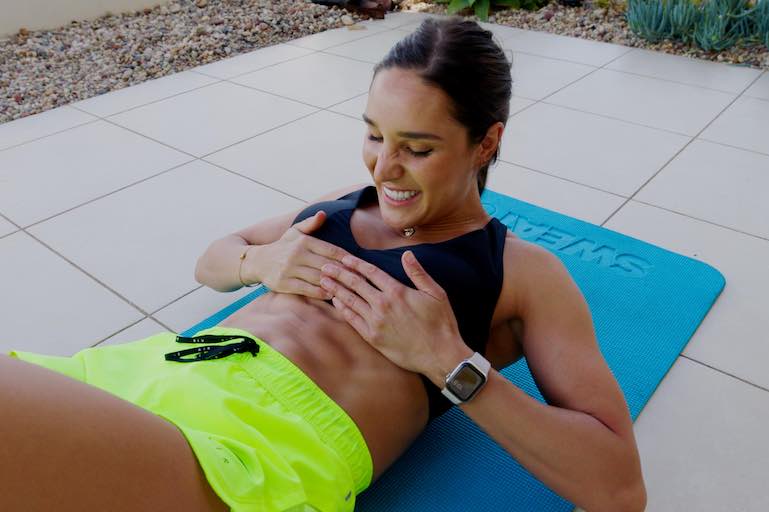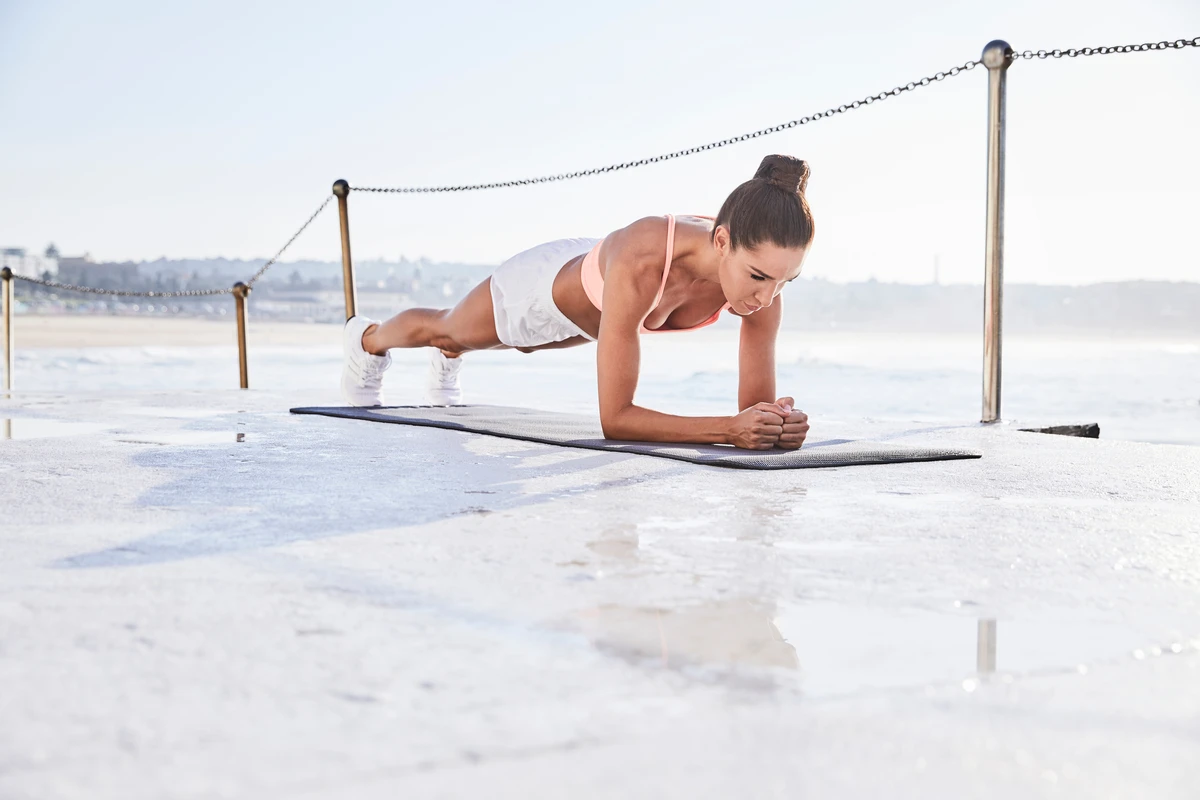6 Best Core Exercises For Beginners

June 10, 2022

When people think about building their core strength, crunches and sit-ups often spring to mind. Beginner ab exercises should be simple, achievable and not too daunting (don’t worry, you won’t find any 5-minute plank holds in this list!), and these exercises definitely fit the bill! Several of them are also on Kayla Itsines' list of favourite ab exercises.
But while crunches and sit-ups have their place and will help strengthen your abdominal muscles, they’re not the ONLY movements you can do.
There are several exercises that are perfect for beginners and will work a range of different core muscles - not to mention make your workouts more interesting. Most of these exercises also keep your spine in a neutral position, which can help you avoid back pain while your core strength is building.
If you’re just starting your fitness journey, core strength is really important for your workouts and life in general. A strong core is essential for stability, balance, good posture and minimising the risk of injury and back pain. It will even make it easier to perform other movements, play sports or with your children or pets, or lift heavy items. And you don’t need any equipment to get started!

Try these beginner exercises for a stronger core
Plank
A plank is a great exercise that will build your core strength while engaging a range of other muscles such as your shoulders and lower body. It will also prepare you for exercises that use similar muscles and movements, such as commandos (& side planks/push-ups), push-ups, mountain climbers and shoulder taps.
Start with your forearms (wrist to elbow) firmly on your mat, ensuring that your elbows are directly below your shoulders.
Extend both legs behind you and elevate your hips off the mat, resting on the balls of your feet. Brace your abdominals and ensure that your spine remains in a neutral position. Hold this position for the specified amount of time, breathing deeply throughout.
The most common mistake when doing a plank is letting your hips sag towards the ground, or lifting your hips up in the air. You want your body to not be in a neutral, straight position - like a plank of wood!
To keep your body straight, focus on pulling your belly button towards your spine, and squeeze your glutes and quads. This will keep your lower body strong and straight, with your hips level. Looking in a mirror or getting someone to check your form can also help.
If you find a plank on your toes difficult, you can either do them for short periods of time (think multiple 10-second bursts), or lower your knees to the ground, ensuring you keep your body in that neutral position to engage your core. As your strength improves try moving onto your toes and increase your time. You can also try side planks or high planks or incline planks on your hands instead of your forearms!
Reverse crunch
If you’re wanting something a bit different to your standard crunch or sit-up, try a reverse crunch! These work your lower abs and can take some pressure off your hip flexors and/or neck, which tend to be used more when performing a sit-up.
Start by lying on your back on your mat.
Lift your feet off the floor and bend your knees so theys are directly above your hips and your lower legs are parallel to the floor (with your knees bent at 90 degrees).
Keeping your back, shoulders and head on the floor, engage your core and bring your knees towards your chest so your hips lift off the ground - keeping your knees bent at 90 degrees.
Slowly lower your hips back to the starting position.
A common mistake when doing a reverse crunch is to use momentum and a rocking motion to propel your hips up with speed. This can also result in your back lifting off the ground or your knees moving out of position. Perform your reverse crunch slowly and with control to get the most out of the movement, letting your body come to a complete stop at the starting position before doing another rep.
Glute bridge
Although it’s called a glute bridge and will definitely work your lower body, this is a great exercise because it uses such a large number of muscles at once, such as your core, glutes, hamstrings, quads and lower back. Including exercises that use multiple muscle groups in your workout will prepare your body for more challenging movements!
Start by lying on your back on your mat with your knees bent, arms resting by your sides and your feet flat on the floor.
Squeeze your glutes and lift your hips off the floor until your knees, hips and shoulders form a straight line.
Lower your hips down to the floor to your starting position. Repeat.
Once you’ve got the hang of a bodyweight glute bridge, you can try holding a weight on top of your hips for more of a challenge. If you’re in a gym or have a barbell at home, you can eventually progress to a hip thrust with a bench or chair, and then to a barbell hip thrust.
Oblique crunch
Change things up and try an oblique crunch to strengthen the muscles down the sides of your core. These might look easy, but you’ll definitely feel the burn.
Start by lying on your right side on a yoga mat with your feet on top of each other and your knees slightly bent.
Put your right arm straight out on the floor in front of you and place your left hand behind your earlobe, as shown. Gently draw your ribs to your hips to engage your core. This is your starting position.
Slowly raise your shoulders and torso off of the floor to bring your left elbow towards your left hip, before lowering back down to the starting position.
Complete an equal number of reps on each side.
Russian twist
Work every muscle in your core by adding Russian twists to your routine, with plenty of options to increase the difficulty!
Start seated on a yoga mat with your knees bent and heels on the mat. Lean back slightly, keeping your back straight, so that your abdominals are engaged and you are balancing on your sit bones. This is your starting position.
While keeping your lower body as still as possible (you don’t want to be rocking forward and back), twist your torso to the right, come back to the centre starting position, then twist to the left.
Continue alternating between left and right.
Ready to make it harder? You can either hold a weight (such as a medicine ball, plate, dumbbell or kettlebell) to try doing Russian twists with some extra resistance, or you can try lifting your feet a couple of inches off the floor.
Toe taps
Time to torch your upper abs! Just like Russian twists, you can easily make this exercise more difficult by holding a weight in your hands.
Start by lying straight on your back on a yoga mat with your legs extended out in front of you. Bend your elbows and place your hands behind your earlobes. Gently raise your legs off the floor so that they form a 90-degree angle at your hips. Engage your abdominal muscles by drawing your belly button in towards your spine. This is your starting position.
Extend your arms to bring your hands up towards your feet — slowly lifting your head, shoulder blades and torso off the mat.
Lower your torso, shoulder blades and head to the mat and place your hands behind your earlobes to return to the starting position. Repeat for the specified number of repetitions.

Dead bugs
Dead bugs are a fantastic exercise to strengthen your core while also stabilising your spine. It’s all about slow and controlled movement - you don’t want to be racing through each rep! They can require a bit more coordination moving your opposite arm and leg (as pictured above), but once you get the hang of it you’ll be away.
Lie on your back with your legs stretched out and your back on the floor.
Raise your arms straight up towards the ceiling and bring your knees up so they are directly above your hips. You want a 90 degree angle at both the hip and the knee.
Lower your right arm until your elbow is by your ear, and at the same time, extend your left leg (opposite) out so it’s straight and hovering above the floor. Your back should remain firmly on the ground at all times to keep your core engaged. Think about drawing your belly button towards the floor!
Bring your arm and leg back to the starting position.
Repeat, alternating sides.
What is your favourite core exercise that is perfect for any fitness level?

A more empowered you starts with Sweat, and our editorial team is here to bring you the latest fitness tips, trainer recommendations, wellbeing news, nutritional advice, nourishing recipes and free workouts.
* Disclaimer: This blog post is not intended to replace the advice of a medical professional. The above information should not be used to diagnose, treat, or prevent any disease or medical condition. Please consult your doctor before making any changes to your diet, sleep methods, daily activity, or fitness routine. Sweat assumes no responsibility for any personal injury or damage sustained by any recommendations, opinions, or advice given in this article.
Fitness